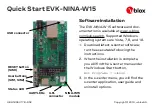
Appendix B
Error Codes and Solutions
© National Instruments Corp.
B-5
NI-488.2M UM for Windows NT
Frequently, the I/O is not progressing (the Listener is not continuing to handshake or the
Talker has stopped talking), or the byte count in the call which timed out was more than
the other device was expecting.
Solutions
•
Use the correct byte count in input functions or have the Talker use the END
message to signify the end of the transfer.
•
Lengthen the timeout period for the I/O operation using
ibtmo
.
•
Make sure that you have configured your device to send data before you request
data.
ENEB (7)
ENEB occurs when no GPIB board exists at the I/O address specified in the configuration
program. This problem happens when the board is not physically plugged into the
system, the I/O address specified during configuration does not match the actual board
setting, or there is a system conflict with the base I/O address.
Solutions
Make sure there is a GPIB board in your computer that is properly configured both in
hardware and software using a valid base I/O address.
EOIP (10)
EOIP occurs when an asynchronous I/O operation has not finished before some other call
is made. During asynchronous I/O, you can only use
ibstop
,
ibwait
, and
ibonl
or
perform other non-GPIB operations. If any other call is attempted, EOIP is returned.
Once the asynchronous I/O has begun, further GPIB calls other than
ibstop
,
ibwait
,
or
ibonl
are strictly limited. If a call might interfere with the I/O operation in progress,
the driver returns EOIP.
Solutions
Resynchronize the driver and the application before making any further GPIB calls.
Resynchronization is accomplished by using one of the following three functions:
















































